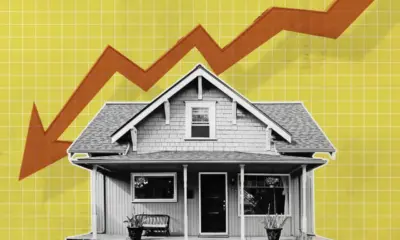Business
London’s Real Estate Revival: How Global Investors Are Returning to the City

After several years of market uncertainty due to Brexit, pandemic-driven disruption, and changing commercial demand, London’s real estate sector is experiencing a notable revival in 2025. Analysts from Bloomberg, Reuters, and the Office for National Statistics (ONS) suggest that global investors are increasingly returning to the capital, attracted by stabilising yields, urban regeneration projects, and long-term growth prospects. From commercial offices to residential developments and mixed-use properties, London is regaining its status as a leading global investment hub.
Commercial Property Recovery
The commercial office sector has seen significant inflows of capital, particularly in the City of London and Canary Wharf. Analysts note that vacancy rates, which spiked during the pandemic, are declining as hybrid work models settle and companies seek flexible office solutions. Institutional investors are targeting prime office assets, particularly those with sustainability certifications and adaptive layouts. Recent data indicates that occupancy in central London office buildings has risen to 88 percent in Q3 2025, up from 75 percent in 2023, signalling renewed confidence among tenants and investors alike.
Retail and mixed-use developments are also benefiting from increased investor interest. Projects that integrate residential, commercial, and leisure spaces are attracting high-net-worth investors seeking diversified exposure. Analysts suggest that demand for well-located, multi-functional assets is driving both domestic and international investment, with European and Middle Eastern investors showing particular enthusiasm.
Residential Market Dynamics
London’s residential sector has experienced a resurgence, driven by low mortgage rates, urban regeneration initiatives, and demand for high-quality housing. Analysts highlight that luxury and mid-market segments are attracting global buyers, particularly from Asia, the Middle East, and North America. In addition, government-backed affordable housing schemes are stimulating construction activity and supporting long-term urban planning objectives.
Rental yields are stabilising, with prime central London areas offering between 3–4 percent net yields and outer boroughs presenting slightly higher returns. Analysts note that rental demand has been bolstered by post-pandemic migration trends, urban employment growth, and renewed confidence in city living. The combination of rising rental income and long-term capital appreciation prospects is enticing institutional and private investors alike.
International Investor Inflows
Global investors are returning to London real estate in significant numbers. Reports from Knight Frank and CBRE indicate that Middle Eastern sovereign wealth funds, Asian family offices, and North American institutional investors account for approximately 40 percent of recent high-value transactions. Analysts attribute this resurgence to London’s political stability, transparent regulatory environment, and continued prominence as a financial and cultural hub.
Cross-border investment is further facilitated by improved capital flow mechanisms, stable currency conditions, and transparent taxation structures. Investors are particularly attracted to commercial buildings with green certifications, heritage residential properties, and mixed-use developments that balance yield and capital appreciation potential.
Financing and Liquidity
Bank lending conditions for real estate projects in London have improved, with competitive mortgage rates and increased availability of construction finance. Analysts suggest that the combination of low-interest rates, attractive yields, and government-backed regeneration incentives is enhancing liquidity in both commercial and residential markets. Institutional capital is increasingly paired with debt financing to optimise leverage and maximise returns, particularly for high-profile redevelopment projects in central London.
Impact of Sustainability and ESG Considerations
Sustainability and ESG compliance are increasingly critical factors driving investment decisions. Office buildings with energy-efficient designs, low-carbon certifications, and climate-resilient features are commanding premium valuations. Analysts highlight that investors are seeking properties that not only provide financial returns but also meet environmental and social governance criteria, reflecting a broader shift towards responsible investment practices.
Residential developments incorporating sustainable building materials, energy-efficient designs, and communal amenities are similarly attracting international buyers. This trend is accelerating urban regeneration projects while ensuring long-term resilience of real estate assets in the capital.
Government Policy and Urban Development Initiatives
Government initiatives play a crucial role in London’s real estate revival. Policies aimed at easing planning restrictions, incentivising regeneration, and supporting affordable housing are contributing to market confidence. Analysts note that public-private partnerships for large-scale urban projects are attracting both domestic and international investment, providing stability and long-term growth prospects.
Infrastructure improvements, including transport upgrades, digital connectivity enhancements, and green spaces, are further enhancing the attractiveness of key districts. London’s ongoing investment in cultural, educational, and commercial infrastructure reinforces the city’s position as a preferred destination for global capital.
Challenges and Considerations
Despite the positive trends, investors must navigate several challenges. Market volatility, potential interest rate fluctuations, and evolving tenant demand in commercial office spaces present risk factors. Analysts advise that careful due diligence, diversified portfolio strategies, and ESG-aligned investment practices are essential for managing potential exposure.
Brexit-related regulatory nuances continue to influence cross-border investment structures, and international investors must remain attentive to changing policies, tax implications, and compliance requirements. Analysts emphasise the importance of professional advisory services in optimising investment outcomes in London’s evolving real estate landscape.
Future Outlook: Sustained Growth and Innovation
Looking forward, London’s real estate market is expected to sustain its revival through 2025 and beyond. Analysts predict continued inflows from international investors, supported by urban regeneration projects, multi-functional developments, and sustainable building initiatives. Prime office and residential sectors are likely to maintain steady yields, while mixed-use and ESG-compliant properties may experience accelerated appreciation.
The combination of government policy, investor confidence, and global appeal positions London as a resilient real estate hub. Innovations in property technology, data-driven asset management, and flexible leasing arrangements will further enhance market efficiency and attractiveness.
Conclusion
London’s real estate revival demonstrates the city’s enduring global investment appeal. Commercial and residential sectors are witnessing renewed confidence, driven by infrastructure improvements, sustainability initiatives, and international investor inflows. Multi-functional developments and ESG-aligned projects are shaping the future of urban investment, while financing mechanisms and regulatory clarity provide operational confidence. Analysts agree that global capital is returning to London, reinforcing its status as a preeminent hub for long-term real estate growth, innovation, and sustainable urban development.




















